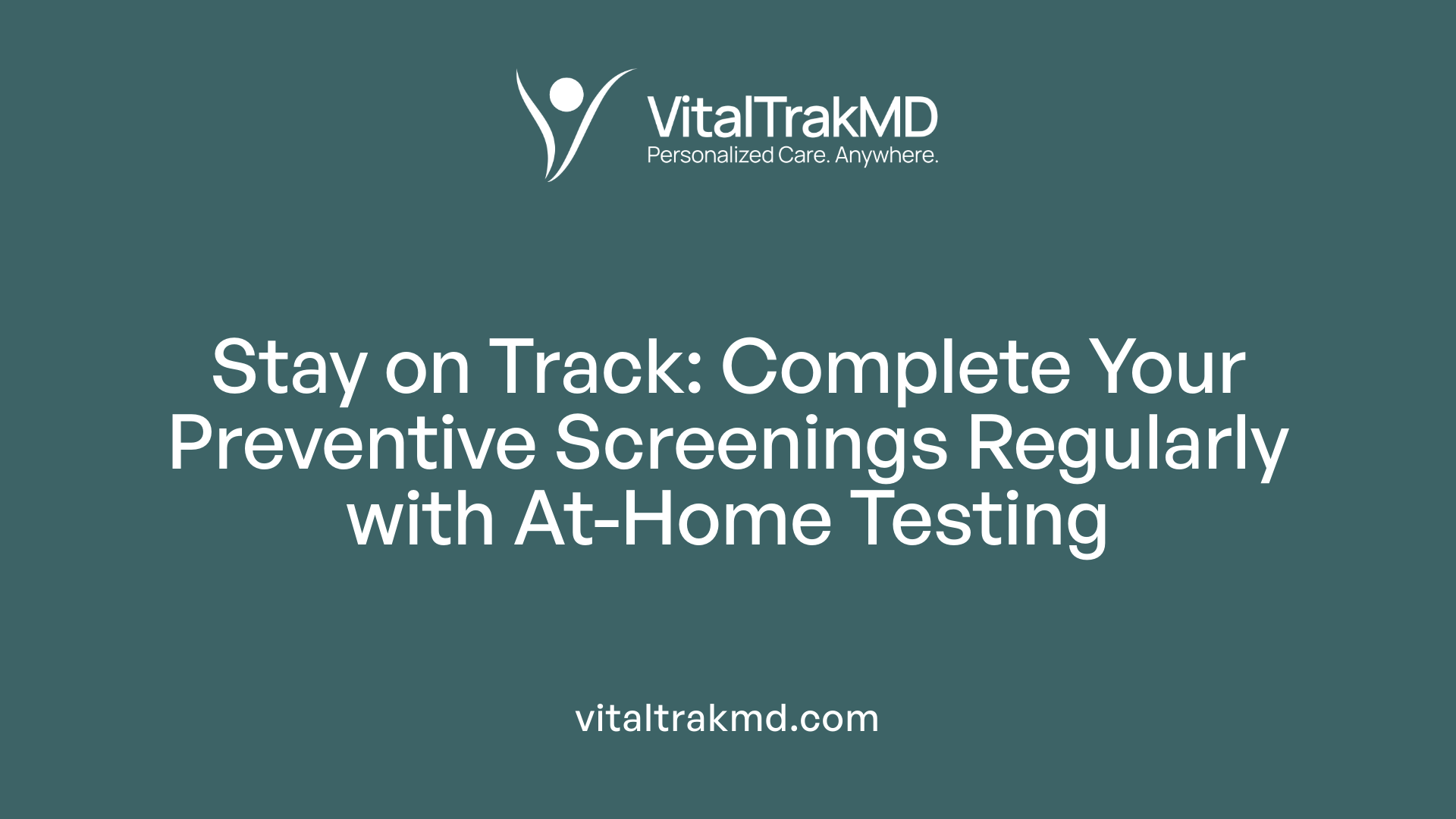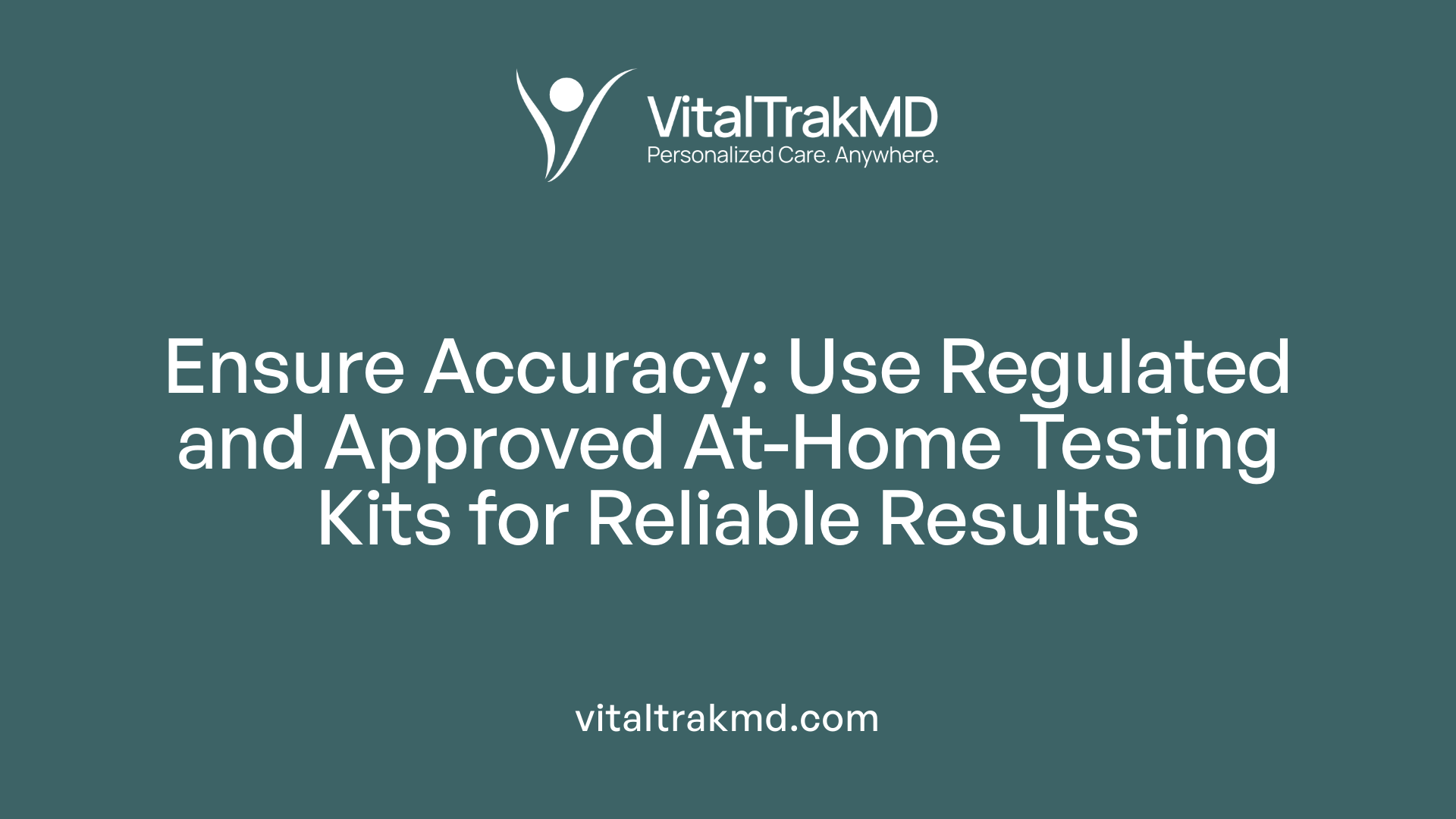Ensuring Preventive Screenings Are Completed with At-Home Labs

The Shift Toward Convenient, Accessible Screening Solutions
As healthcare continues to evolve, at-home preventive screening services are becoming an essential component of routine health management. These innovative solutions empower individuals to monitor their health conveniently and privately, addressing traditional barriers like mobility issues, limited access, and time constraints. This article explores how at-home labs work, their role in preventive health, and strategies to ensure their effective implementation.
The Process of At-Home Preventive Screening Services

How do at-home preventive screening services work and what is their process?
At-home preventive screening services have revolutionized healthcare by offering convenient and private options for health monitoring. These services provide individuals with testing kits designed for self-administration within the comfort of their homes. The process begins with purchasing a kit, which can often be done online through providers like Quest Diagnostics, EverlyWell, or RevDoc, or picked up at pharmacies.
Once the person receives the kit, they follow step-by-step instructions to collect the required samples. Depending on the test, samples could include blood (via fingerstick), saliva, urine, stool, or other biological materials. Proper sample collection is crucial for accurate results; instructions are usually clear and straightforward to ensure correct procedures.
After collection, individuals mail their samples back to certified laboratories using pre-paid shipping labels included in the kit. Major labs like Quest or LabCorp process these samples in CAP or CLIA-accredited facilities, ensuring standards of quality and reliability.
Following analysis, the labs generate results that are reviewed by healthcare professionals and then shared with the patient. Many services provide results through online portals, allowing quick access and easy interpretation. Results are often sent within a few days, and some providers offer follow-up consultations with healthcare providers for further discussion.
This entire process emphasizes privacy, ease of use, and reduction of barriers such as transportation or clinic visits. It enables early detection of health issues like diabetes, cholesterol problems, or colorectal cancer, helping with timely intervention.
Sample collection and mailing process
Sample collection kits are designed for self-use and are user-friendly. For example, blood samples might require a fingerstick procedure, utilizing lancets included in the kit. Urine and stool tests involve simple collection containers, while saliva samples are typically obtained by spitting into a tube.
After securing the sample, individuals place it in the designated container, sometimes with stabilizing reagents, and seal it properly. The sample is then mailed back to the lab via prepaid shipping labels. Some kits include tracking features to confirm delivery.
Reliability hinges on following instructions carefully. Many kits include visual guides or digital resources to assist users in proper sample collection. Shipping times are generally quick, ensuring the sample reaches the lab promptly for accurate testing.
Analysis and reporting of results
Once the lab receives the sample, technicians conduct the relevant tests - whether detecting colon cancer markers, blood sugar levels, or hormone balance. Results are reviewed by specialists and uploaded to secure online platforms.
Patients can log in to their accounts to access their reports, often accompanied by explanatory notes. Some platforms offer options to share results directly with primary care providers, facilitating further medical advice or treatment.
In case of abnormal findings, timely communication with healthcare professionals is encouraged. Providers may recommend additional tests, lifestyle changes, or treatments based on the results.
Importance of proper usage and follow-up
Proper use of at-home testing kits is vital to ensure accurate outcomes. Users should follow all instructions carefully, avoid contamination, and mail samples swiftly. Incorrect collection can lead to false results, causing unnecessary worry or missed diagnoses.
Follow-up is essential regardless of the results. At-home screening is a preliminary step; confirmatory testing and medical consultation are necessary for diagnosis and treatment planning. Health plans and providers often partner with these services to support ongoing care and improve health outcomes.
Overall, at-home preventive screening services empower people to take charge of their health, reduce barriers to care, and facilitate early detection — all while maintaining convenience and privacy.
Key Preventive Screenings and the Role of At-Home Testing
What are common preventive screenings recommended for adults, including the role of at-home testing?
Preventive health screenings are essential tools for early disease detection and maintaining good health in adults. Standard screenings include blood pressure checks, cholesterol and blood glucose tests, and various cancer screenings. For instance, women are generally advised to undergo mammograms and Pap smears, while men and women at risk for colorectal cancer should consider screenings like colonoscopies or non-invasive stool tests.
In addition, high-risk individuals might be recommended low-dose computed tomography (CT) scans for lung cancer screening. Immunizations such as flu shots, hepatitis vaccines, HPV vaccination, shingles, and tetanus boosters are also part of routine prevention based on age and specific health risks.
Many of these tests traditionally require visits to healthcare providers. However, at-home testing is increasingly complementing routine care. Blood pressure monitoring can now be performed with portable devices, while some colorectal cancer screenings can be done through mailed or self-administered stool test kits. Additionally, at-home kits for blood glucose (like HbA1c tests for diabetics) and kidney health (urine microalbumin tests) help individuals monitor their health easily.
The integration of at-home testing into routine health checks offers numerous benefits, including increased convenience, privacy, and the ability to reach underserved populations who face barriers like transportation issues or busy schedules. These efforts aim to promote early detection, risk reduction, and continuous health management, ultimately contributing to better health outcomes and reduced healthcare costs.
Ensuring Completion and Enhancing Adherence to Preventive Screenings
 Patients can significantly increase their chances of completing preventive health screenings by taking advantage of accessible at-home testing options offered by various programs. These no-cost or low-cost kits, provided through initiatives like EHP, include vital tests for conditions such as colorectal cancer, diabetes, and kidney health.
Patients can significantly increase their chances of completing preventive health screenings by taking advantage of accessible at-home testing options offered by various programs. These no-cost or low-cost kits, provided through initiatives like EHP, include vital tests for conditions such as colorectal cancer, diabetes, and kidney health.
Once the kits arrive, individuals should carefully follow the included instructions to collect their samples—whether saliva, urine, stool, or blood—correctly. Promptly mailing these samples back via prepaid envelopes ensures timely processing. Consistent adherence is essential; patients are encouraged to complete screenings at recommended intervals, typically annually or more frequently if advised by their healthcare provider, especially if they have risk factors.
After the samples are analyzed, results are usually mailed to patients and shared with their primary care providers. Reviewing these results with healthcare professionals helps determine necessary follow-up actions and treatment plans.
Combining at-home testing with routine healthcare visits fosters early detection and continuous health monitoring. This approach not only makes preventive care more convenient but also supports better health outcomes, particularly for those facing barriers to in-clinic visits.
To further promote adherence, patients should stay informed about the importance of regular screenings and maintain open communication with their healthcare team. Regularly updating and following through on recommended tests ensures ongoing health management and reduces the risk of developing advanced health conditions.
Advantages of At-Home Labs for Preventive Health

What are the benefits of using at-home labs for preventive health screenings?
Using at-home labs for preventive health screenings offers several important advantages. First, they enhance privacy and convenience, allowing individuals to complete tests discreetly without the need for in-person visits. This is especially beneficial for sensitive screenings like STD tests or HPV testing, where stigma might deter some from seeking in-clinic care.
Second, at-home testing improves accessibility for underserved populations. People living in rural or remote areas, those with mobility issues, or individuals facing transportation or time barriers can participate fully in health monitoring.
Third, early detection of health issues becomes more achievable. Regular at-home testing facilitates timely diagnosis of conditions such as diabetes, kidney disease, or colorectal cancer, which can lead to better health outcomes through early intervention.
Finally, these kits contribute to cost savings and greater healthcare efficiency. They often reduce the need for unnecessary doctor visits, saving time, reducing healthcare costs, and decreasing the burden on clinics and hospitals.
Overall, at-home labs empower individuals to take proactive control of their health, helping to bridge gaps in care, promote early diagnosis, and support healthier communities.
Ensuring Reliability, Regulation, and Managing Risks of At-Home Self-Testing Kits

Are at-home self-testing kits reliable, accurate, and properly regulated?
At-home self-testing kits can provide reliable and precise results when they are regulated by appropriate authorities such as the FDA in the United States or the European Union’s In-vitro Diagnostics Regulation (IVDR). These agencies evaluate the performance of tests, especially those categorized as higher risk, to ensure they meet specific standards for accuracy and consistency.
Many self-test kits undergo testing and evaluation before they reach consumers. For instance, some kits are assessed for their analytical performance, which determines whether they can correctly detect the presence or absence of a condition. However, the level of validation can vary; only a small number of tests have extensive independent validation, while others may rely on manufacturer evaluations.
Regulation also covers the usability of kits. This is crucial because many individuals perform these tests without professional supervision. They must be designed to be simple and straightforward, with clear instructions to reduce user errors.
While most modern kits are developed with high standards and can deliver results comparable to laboratory tests, accuracy can depend heavily on proper usage. Factors such as storage temperatures, sample collection procedures, and reading timing all impact the validity of results.
In recent years, regulatory bodies have enhanced their review processes. Under the updated IVDR, for example, by 2022, all self-tests in the EU are required to undergo more thorough assessment, including evaluating their clinical utility and performance with lay users. Despite these improvements, the current landscape still features some variability in test quality.
Consumers should remain cautious and prioritize using tests from reputable manufacturers that are authorized and have clear performance data. Following the instructions meticulously and consulting healthcare professionals when interpreting results is vital. For critical testing, especially for diagnoses or conditions with serious health implications, confirmatory testing under professional supervision is always recommended.
In summary, properly regulated and correctly used self-testing kits can be reliable tools for health monitoring. However, awareness of their limitations and the importance of choosing authorized tests ensures users obtain the best possible outcomes.
Moving Forward with At-Home Screenings
The integration of at-home preventive screening tests into healthcare strategies offers a promising avenue to improve early disease detection, patient engagement, and overall health outcomes. While the process is straightforward, ensuring the reliability of tests through regulation, educating patients on appropriate use, and fostering collaboration between healthcare providers are essential for maximizing benefits. As technology advances, at-home testing will likely become a vital part of routine health monitoring, making preventive care more accessible, personalized, and effective for all populations.
References
- In-Home Preventive Screenings & Services - Retina Labs
- Preventive screenings at-home for select members
- Encouraging Patients to Accept & Return In-Home Lab Test Kits
- Home self-testing kits: helpful or harmful? - PMC
- Convenient, reliable at-home testing for colorectal cancer and ...
- At-Home Lab Testing | Preventive Care - Everlywell
- Is At Home Lab Testing Right for Your Practice? - Healthie
Recent articles
Want to Feel Better and Live Healthier?
Join hundreds of patients taking control of their health with personalized care that fits their life – not the other way around.
Rated 4.8/5 by 32+ customers







